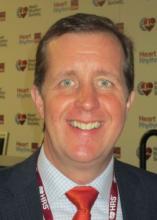SAN FRANCISCO – Defibrillation testing at the time of implantable cardioverter defibrillator implantation is safe, but it does not improve clinical shock efficacy or prevent death, results from a large, randomized trial showed.
"Implanting an ICD without routine testing should be the preferred approach now. In some countries, like Canada, this has been the approach for 80% of people," Dr. Jeffrey S. Healey said during a press briefing at the annual scientific sessions of the Heart Rhythm Society. The results have the potential to "change guidelines, especially in the United States where the majority of ICDs are implanted with testing."
For the study, known as the SIMPLE (Shockless Implant Evaluation) trial, 2,500 patients at 85 sites in 18 countries undergoing their initial ICD implant were randomized to defibrillation testing (DT) or to no DT at the time of implant. The DT protocol required one or more successful terminations of ventricular fibrillation at 17 J or two terminations at 21J, with system revision if criteria were not met. The primary outcome was a composite of failed appropriate clinical shocks or arrhythmic death. "We thought this was an important clinical outcome because that’s really what the testing is meant to do; it’s meant to improve the likelihood that the device will successfully terminate an episode of ventricular tachycardia and ventricular fibrillation," said Dr. Healey, the study’s lead author who is director of arrhythmia services at Hamilton (Canada) Health Sciences. "We also looked at all-cause mortality because that’s clearly important."
The researchers additionally evaluated two safety clusters of periprocedural risk within 30 days of surgery. The first safety cluster looked at any complication which conceivably could be related to DT itself. The second safety cluster looked at episodes that are more clearly established to be related to DT, such as the need for cardiopulmonary resuscitation, unplanned intubation, stroke, heart failure, and death.
The mean age of patients was 63 years and 81% were men. During a follow-up of 3.1 years, 1.7% of patients were lost to follow-up. Failed appropriate clinical shocks or arrhythmic death occurred at an annual rate of 7.2% in the study arm of patients who did not have device testing, compared with a rate of 8.3% in the arm that had device testing (hazard ratio 0.86; P value of less than .001 for noninferiority). Total mortality was similar in both groups (HR 1.04: P = 0.65).
Device testing "did not seem to improve outcomes at all," commented Dr. Healey. "We set this up as a noninferiority trial to show that implantation of an ICD without testing was noninferior to implantation with testing. We very much succeeded in showing that was the case. The P value was less than .001 for noninferiority."
In terms of safety, the researchers observed a nonsignificant trend in favor of a slight increase in complications in the first safety cluster. "The second safety cluster of events more closely linked to shock testing was significantly increased with a borderline P value of .047, or a 50% increase, going from a 3% complication rate to 4.5% complication rate with testing," he said.
The likelihood of successful shock was numerically higher in patients who did not having the testing, "but this was not statistically significant; the P value was .08," Dr. Healey said. "We conclude that ICD implantation without testing does not give up any of the benefit of the ICD, that it is noninferior to implantation with testing using that primary outcome of failed shock or arrhythmic death. Overall, the complication rates from either strategy are low. There was a small but measurable increase with the testing procedure but overall we’ve come a long way with ICD therapy in the last 20 years. The therapy works; it’s highly effective, and clinicians can place it with very low risk."
SIMPLE was funded by a grant from Boston Scientific. Dr. Healey said that he had no relevant financial conflicts to disclose.


